Return loss is an important new test measurement for local area networks, especially those migrating to higher speed protocols. Here’s proof that high quality DataMax 6 patch cords actually improve LAN channel performance for more throughput, less downtime and greater efficiency.
How DataMax 6 patch cords improve performance
Return loss (RL) is a very important noise measurement recently defined for local area networks (LANs) and LAN components. This statement raises an obvious question: Since LANs have been around for years and RL is very important, then why is RL relatively new and now being defined?
The answer is simple but not obvious. Engineers designing LAN systems and components have known that RL is present, but up to now it did not matter in their designs, so they did not bother defining or quantifying it. Now, with faster and bidirectional signaling being implemented, RL matters.
Return Loss did not previously matter because most LANs operate using 10 or 100 Base-T protocols. Both of these signaling schemes use two pairs of conductors—one pair to send data and the other to receive. In each scheme, signal energy travels unidirectionally from a transmitter at one end of each pair to a receiver at the other end. Thus, only two pairs of the commonly-used four pair cables are actually energized. Before we get into detailed discussions on RL, we should briefly explain the differences between unidirectional and bidirectional signaling.
Unidirectional and Bidirectional Networks
Figure 1 illustrates data energy traveling unidirectionally through a two pair network. As you would expect, the signals lose energy (attenuate) as they travel through the cable and connectors. There is also some undesirable signal induced from one pair to another, which is called crosstalk. Crosstalk is the major noise source in most 10 or 100 Base-T Ethernet networks.
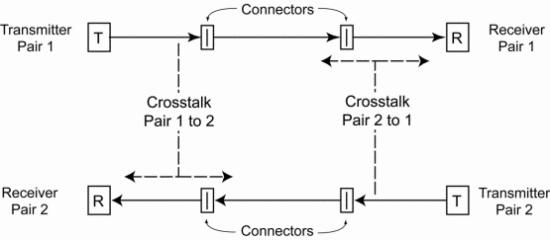
The unwanted crosstalk noise propagates in both directions through the other pair, but noise is only a problem at a receiver because it interferes with the received signal. Noise at a transmitter can be ignored. This explains why, in unidirectional systems, near end crosstalk noise (NEXT) must be recognized and quantified, and far end crosstalk noise (FEXT) can be ignored. This is also why the attenuation to crosstalk ratio (ACR) for a unidirectional network is so important. ACR closely approximates the signal to noise ratio that electronics engineers measure as a critical system performance indicator.
Today, many LAN owners are beginning to implement faster signaling protocols. They are considering 1000 Base-T or even 10 Gigabit Ethernet signaling. These protocols are far more complex, have much lower signaling energies and are more susceptible to noise. These newer, faster methods also use bidirectional signaling.
Bidirectional signaling changes all the conventional measurements for a LAN. As Figure 2 shows, there is now a combination transmitter/receiver (transceiver) chip at each end of each pair. Crosstalk noise still propagates both directions in each pair, but now the far end noise (FEXT) can no longer be ignored because it also affects a receiver.
Worse, these new and faster protocols use all four pairs in the cable, with each pair signaling bidirectionally. For simplification, Figure 2 only shows a two pair network, but in a four pair network the crosstalk noise affecting any pair must be added from all three other pairs. This measurement is termed power sum crosstalk, and is measured both near end and far end (PSNEXT and PSFEXT). Simple two pair unidirectional networks, which could be quantified by measuring just signal attenuation and NEXT, are being replaced by more complex bidirectional networks, for which attenuation, PSNEXT and PSFEXT must now be measured and addressed.
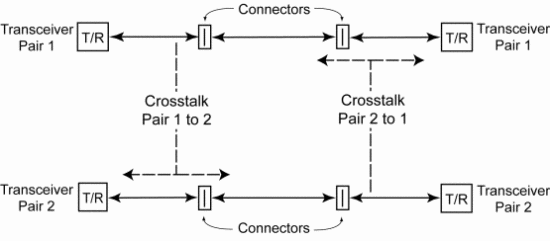
Bidirectional signaling not only complicates the older signaling measurements, it also adds new ones. Return loss (RL) is one of these new, very important measurements. RL is a summation of all the reflected signal energy coming backward toward the end where it originated. It is like an echo and must not be confused with crosstalk. Since each end of each pair has a transceiver chip, the same data stream sent out by the transmitter gets echoed back to the receiver, which is “listening” for data from the transmitter at the other end. The echo is real data, but since it interferes with the desired signal, it must be treated as noise.
What Causes Return Loss?
There are two major causes of RL in a network: discontinuities and impedance mismatches. Discontinuities occur at connections where cable is terminated to plugs or jacks and within the plug/jack connection itself. A discontinuity can also occur if a cable is bent too much, kinked or otherwise damaged. When a transmitted signal pulse hits one of these structural discontinuities, echo or RL occurs.
Impedance mismatches can be macro or micro in scale, and both are important. Macro mismatches are usually component-to-component related. If the horizontal cable in the network averages 100 ohm impedance and the flexible patch cords are 106 ohms, each 6 ohm mismatch also causes an RL reflection.
Micro impedance variations along a cable’s length are subtler but also important contributors to RL. Manufacturing tolerances during the construction of a twisted pair causes these variations. The precise impedance of a pair is determined by the insulation material used, the diameter of the copper, the diameter of the insulation, the centering of the copper within the insulation, and the precision with which the two insulated wires are twisted together. If any or all of these factors vary during the manufacture of a twisted pair, the impedance will vary along its length. Thus, the horizontal cable mentioned above with an average impedance of 100 ohms, may have a given 3 feet section at 95 ohms, the next 3 feet at 97 ohms, the next 100 ohms, etc. These micro variations in impedance along a pair are small, but they affect high frequency signals, adding a cumulative signal echo. Figure 3 illustrates the combination of these various return loss effects within one pair.

A perfect transmission line would have no imperfections, connections or impedance variations along its length, and therefore would have no return loss confusing the receiver. However, this is the real world and our networks are built using twisted pair with plugs and jacks as connections. 10 Base T Ethernet with unidirectional signaling is not affected by low levels of RL, but the newer and higher speed protocols are, so now RL must be understood and quantified. Too much RL noise added to the PSNEXT and PSFEXT adds to the noise budget resulting in increased bit error rate, lower signal to noise ratio, less network operating margin and more downtime.
Mechanical Vibration Analogy
Another way to understand RL is to think about signal pulses in a network using the mechanical analogy of vibrational frequencies. Remember that 10 Base T, 100 Base T and other protocols do not transmit data at a single frequency. They use a spectrum or bandwidth of frequencies. A single pulse is really a packet of frequencies. The steep rise and fall portion of the pulse can be represented by relatively high frequencies and the flat, stable portion of a pulse can be characterized by lower frequencies. Thus, every data stream of bits and bytes can be seen as a very complex package of many different electronic vibrations.
Mechanical or structural engineers must analyze and predict how a bridge, high-rise building or turbine blade will react to a range of vibrational energies. They know that each mechanical component will react strongly to certain frequencies (harmonics) and will relatively ignore other frequencies. They also know that a larger structure, such as a bridge, has its own unique response to a range of vibrations. You cannot simply add up or sum the responses of all the individual components to calculate how the larger structure will behave.
Return loss in a network is very similar. All the plugs, jacks, cords, cable and other components must be individually analyzed to assure that they are appropriate to function as part of the system, but ultimately the entire network must be tested. As with the mechanical analogy, you cannot add up or simply sum the RL of individual components to calculate how the larger network will respond. RL is not “cascadable”. Also, networks will behave differently when tested from opposite ends because they are usually not symmetrical.
Figure 4 is actual RL test data from a real network, measured using a network analyzer. The test is from the wall plate or work area end. The channel consists of various hardware (wall plate, patch panels, connectors), 90 meters of horizontal cable and three patch cords totaling 10 meters. Each colored trace shows the RL performance of one pair through the network. The horizontal orange line that angles upward at 20 MHz is the defined RL limit line for a Category 5e channel. The further below this limit line, the better the channel. You see that this channel passes the Category 5e return loss requirements.
Now let’s analyze the data. Exactly what does it reveal? Remember that a data stream is really a very complex package of different electronic vibrations. The network analyzer has injected over 500 different frequencies into the channel and is recording the total reflected energy returned to the wall plate end. Each component and the network as a whole are in a steady state, reacting to the input bandwidth of energy. Put another way, Figure 4 is a steady-state photograph of all the signal echoes at the wall plate end of this network. Every connection, cable and patch cord is responding to the full bandwidth or spectrum of frequencies and reflecting some of the energy back toward the wall plate (and into the PC network card connected to it).
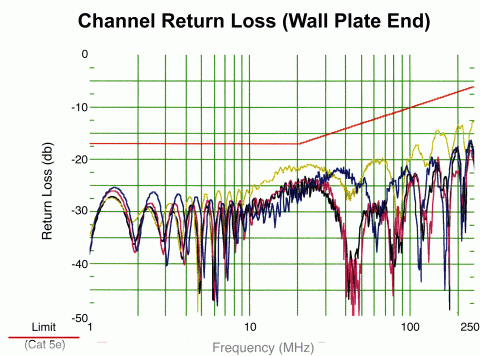
Similar to tuning forks, the smaller components tend to respond to the higher frequencies and the larger components tend to react to the lower frequencies. Thus, the plugs and jacks dominate the response at frequencies above 100 MHz and the long horizontal cable dominates the lower frequencies below 7-8 MHz. The patch cords resonate to the mid-frequencies. In fact, the upward bump in the RL curves from 8 MHz through 40 MHz could be improved or flattened out with the use ofDataMax 6, a better patch cord.
The above frequency statements are valid generalities if the network components are reasonably good, as they are in this particular network. However, if one component is defective or is of very poor quality, the RL response curve can get very unpredictable, with the bad component causing echoes at frequencies where you would not expect to see them. For instance, if the patch cord and horizontal cable had a severe impedance mismatch, you would see the entire RL response curve shift upward by 5-10 dB.
Frequency-Domain Measurements Compared to Time-Domain Measurements
Figure 4 shows the total reflected energy at specific frequencies. This is called a frequency-domain measurement; however, the network analyzer can convert this data to show it in time-domain. It does this by using a complex mathematical function called Discrete Fourier Transformation. It is the same data, but converted so that the reflected echoes are plotted against time.
To understand what time-domain data means, think about a sound echo. Across a mountain valley, your “hello” can echo back several times as it is reflected off distant cliffs or mountain faces. If you know the speed of sound and time how many seconds it takes until you hear each echo return, you can easily calculate the distance to each echo source.
Figure 5 shows return loss data plotted in time-domain. Since the signal velocity through the network is a known constant, like the sound velocity in our analogy above, the time it takes for the reflections or echoes to return can be converted to distance. For reference, 20 nanoseconds equals about 4 meters. However, since the signal must go and then the echo return, the physical distance to the RL source is half of whatever distance is calculated.
Figure 5 shows the RL response through each pair or circuit at the wall plate end of the network. Compared to Figure 4, the data is now like a radar pulse or probe into the network. The network analyzer is processing every discrete frequency injected into the network, comparing that data to the echoes received, then computing the total reflected energy at distances from the wall plate end.
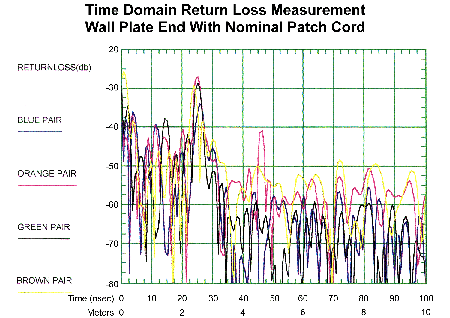
Notice what a strong diagnostic tool time-domain RL data provides. The bump upward beginning at two meters is the wall plate connection. The plug-to-jack connection combines with the physical termination of the cables on either side of the wall plate to contribute a significant echo or RL. As you look at the two meter work area cord, you can see some cyclical variations in return loss for any given pair. These are due to micro impedance variations along each pair’s length. Also, notice that the RL along the first two meters of work area cord is higher than that shown for the horizontal cable beyond the wall plate. This occurs because the cord does not have an impedance of exactly 100 ohms, matching the horizontal cable. Also, the patch cord has micro mismatches along its length.
Figure 6 shows you can achieve about 10 db of RL improvement simply by switching to DataMax 6 cord. Notice that the cord’s RL contribution is now of an order of magnitude similar to that of the horizontal cable. Also notice that, as you look further into the channel away from the measurement end, the measured returns decrease. This is due to signal attenuation in the channel. The signal sent is attenuated, as are the reflected returns.
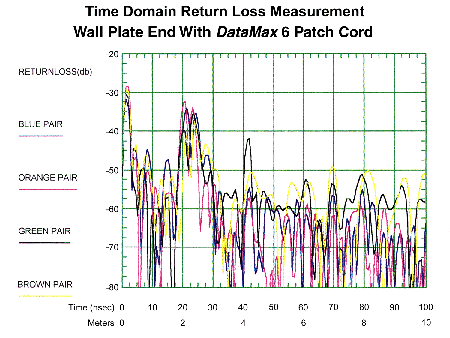
Because of attenuation, RL is usually an “end” effect. Unless a network has a bad horizontal cable or mechanical damage somewhere along its length, the first 10-15 meters at either end are most important. Looking from either the work area or equipment end of a channel, the first and most important component the signal sees is a flexible patch cord. This is why patch cord quality is becoming critically important for networks migrating to higher speeds.
In summary, RL measured in frequency-domain provides a pass/fail measurement for a network because it is possible to compare the actual data to a specification limit line. In contrast, RL measured in time-domain provides a potent diagnostic tool to be used when a network fails or is in trouble. In time-domain you can look inside your network to see where the problems are. In response to this issue, most of the new hand-held testers are capable of measuring RL in both time and frequency domain.
Return Loss Also Distorts Signals
The problem that a return echo presents at the near (or measurement) end of a network is relatively obvious, and everything that we have discussed so far has dealt with that issue. Unfortunately, RL also has a far end effect that is more complex and currently not widely understood. The fact is that RL also contributes to transmitted signal distortion. This signal distortion is very important with any of the newer, faster protocols, and is not related to bidirectional signaling in any way. Lower speed, unidirectional protocols such as 10 Base T could ignore this effect because they have high signal to noise ratios. However, faster data encoding schemes cannot, even though they may be unidirectional.
To increase signaling speeds, designers must use narrower, higher bandwidth pulses. These pulses are spread out and distorted during transmission through a network. This distortion is due to attenuation and phase shift variations in the network and results in received pulses interfering with each other (ISI or inter-symbol-interference).
Both attenuation and phase shift vary with frequency, and increasing RL increases their variation. Thus, the higher frequency components of each pulse arrive at slightly different times compared to the lower frequency components. The phase distortion also causes the received pulses to be asymmetrical.
The bottom line is that neither digital nor analog equalizers can completely compensate for all this pulse distortion. The network must absorb the uncompensated noise out of an already thin noise budget. The result is less operating margin, more bit errors, more retransmissions, and a less efficient network. For a more detailed analysis and explanation of how RL distorts transmitted signals, refer to the white paper Return Loss and Data Transmission.
Summary and Conclusions
This article began with an explanation of the differences between today’s two pair unidirectional networks and tomorrow’s faster, bidirectional signaling schemes. We explained why near end crosstalk (NEXT) would no longer be the sole significant noise source in a network. Far end crosstalk (FEXT) must now be considered, and when more than two pairs are used for signaling, both NEXT and FEXT must be power summed. Last, we introduced a third significant network noise source, return loss.
This article began with an explanation of the differences between today’s two pair unidirectional networks and tomorrow’s faster, bidirectional signaling schemes. We explained why near end crosstalk (NEXT) would no longer be the sole significant noise source in a network. Far end crosstalk (FEXT) must now be considered, and when more than two pairs are used for signaling, both NEXT and FEXT must be power summed. Last, we introduced a third significant network noise source, return loss.
We discussed RL measurement in both frequency and time-domain and explained why network performance cannot be summed from component data. We also explained why RL performance is usually an end effect and therefore very dependent upon patch cord and connector quality. Last, we described return loss’ most complex effect, signal distortion. This distortion is in many ways the worst effect of all, because signal equalizers cannot be made “smart” enough to compensate for this loss.
Migrating to Gigabit Ethernet (1000 Base T) or faster will stress existing networks. Cramming more and faster signal data into the same period of time means using higher frequency, lower energy signals that will be more susceptible to noise. And, as this article has demonstrated, there will be more noise sources.
There is, ultimately, good news. Channel test data provides strong proof that legacy networks can migrate successfully to these higher speed protocols, and the lowly patch cord is a significant part of this migration. High quality DataMax 6 patch cords, built with the best plugs and flexible stranded cable, actually reduce channel return loss and increase channel performance margin. This, in turn, reduces bit errors, signal distortion, and retransmissions. Channel throughput is increased, resulting in less downtime, less troubleshooting and happier network users.

